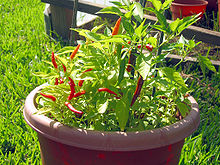Piri piri
This article needs additional citations for verification. (June 2011) |
| Piri piri | |
|---|---|
| Heat | |
| Scoville scale | 50,000-175,000 SHU |
| Piri piri | |
|---|---|
 Piri piri peppers (ripe and unripe) | |
| Species | Capsicum frutescens |
| Cultivar | Piri piri |
Piri piri (pili pili, peri peri) is a cultivar of Capsicum frutescens, one of the sources of chili pepper, that grows both wild and domesticated. It is a small, extremely spicy member of the Capsicum genus. It grows in Malawi, South Africa, Ghana, Nigeria, Zimbabwe and Mozambique.
Etymology
African Birds Eye Chili is also called peri peri, pili pili, or piri piri.[1] Pili pili is the Swahili word for 'pepper pepper'.[2] Other English language spellings may include pili pili in the Democratic Republic of the Congo or peri peri in Malawi, deriving from the various pronunciations of the word in parts of bantu language group speaking Africa. Piri piri is the spelling of the name as used in the Portuguese language, namely in the Portuguese speaking Mozambican community, to describe the African bird's eye chili.[3] “There’s a lot of debate about how the piri-piri pepper came to Portugal,” says Dave DeWitt, author of The Chile Pepper Encyclopedia (Morrow, 1999). “The peppers were originally brought back on Columbus’s voyage to the Americas. Most people believe that the Portuguese took the chiles to their colonies of Mozambique and Angola, where they were christened a Swahili word that means ‘pepper-pepper,’ and naturally cross-pollinated. Eventually, one of the varieties made its way to Portugal, where, for some reason, it retained its African name.”
The Oxford Dictionary of English records "piri-piri" as a foreign word meaning "a very hot sauce made with red chilli peppers" and giving its origin as the Ronga (a Bantu language of southern Mozambique) word for "pepper".[4]
Plant characteristics
Plants are usually very bushy and grow in height to 45-120 centimeters, with leaves of 4–7 cm length and 1.3-1.5 cm width. The fruits are generally tapered to a blunt point and measure up to 8 or 10 centimeters long. Immature pod color is green, mature color is bright red or purple. Some varieties of birdseye measure up to 175,000 Scoville heat units.

Cultivation
Peri peri has grown in the wild in Africa for centuries and is now cultivated commercially in Uganda, Malawi, and Zimbabwe.[5] It grows mainly in Malawi, South Africa, Ghana, Nigeria, Zimbabwe and Mozambique.[1] It is cultivated for both commercial food processing and the pharmaceutical industry. Cultivation of peri peri is labor intensive.[5]
Piri piri sauce
Piri-piri sauce (used as a seasoning or marinade) is Portuguese in origin and "especially prevalent in Angola, Namibia, Mozambique and South Africa".[6] It is made from crushed chillies, citrus peel, onion, garlic, pepper, salt, lemon juice, bay leaves, paprika, pimiento, basil, oregano, and tarragon.[7]
See also
- Malagueta pepper (Capsicum frutescens var. malagueta, Solanaceae)
- List of capsicum cultivars
- Capsicum frutescens
- Capsicum
References
- ^ http://www.nandos.co.uk/story/index.html
- ^ http://www.nandos.co.uk/story/index.html
- ^ "piri-piri noun", Angus Stevenson (ed.), Oxford Dictionary of English. (Oxford University Press, 2010, Oxford Reference Online) accessed 24 February 2012.
- ^ a b "Fiery Foods and Barbecue SuperSite - Pepper Profile: African Birdseye". Fiery-foods.com. Retrieved 2011-12-27.
- ^ Rowley Leigh, "A Fiery Challenge for Delicate Palates", The Financial Times (London, England), 25 September 2004, p 6.
- ^ "piri-piri" in David A. Bender (ed.). A Dictionary of Food and Nutrition, (Oxford University Press, 2009) via Oxford Reference Online (Oxford University Press) accessed 24 February 2012.
External links
- Pepper Profile: African Birdseye at www.fiery-foods.com
- Pirri Pirri at www.pirripirri.com
- PlantFiles: Detailed information on Hot Pepper Capsicum frutescens 'African Devil' at davesgarden.com
